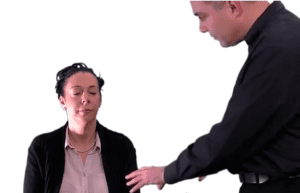One of the most fun techniques in NLP at Practitioner level is the NLP Swish Pattern. This NLP technique is used by NLP Practitioners to help clients develop better, more empowering behaviours. It can be used to help people quit smoking, change eating preferences and feel differently about upcoming events that they may be apprehensive about such as public speaking amongst other things.
The NLP Swish pattern is a technique involving Submodalities. Submodalities are the finer distinctions to our internal pictures, feelings and sounds and represent themselves to us in the form of our thoughts.
If you think of your last holiday, do you have a mental picture of that holiday that springs to mind? Any feelings? Any smells or tastes? Normally we get these thoughts and they are just thoughts, they come and go. The thing about thoughts is that they repeat themselves. 95% of the thoughts that you have today are the same as the thoughts that you had yesterday. So if all of your thoughts are empowering for you, then great. If you have some thoughts that are not useful for you, then you might be better off changing them, so that the next time you have that same thought, it is a thought that you want and not what you don’t want. In NLP we enable people to be able to assess these thoughts, break them down and change them using Submodalities.
 In order for a Swish pattern to be effective and produce lasting results there are certain conditions that need to be met on the part of the client and on the part of the Practitioner. Here are 9 keys to successful NLP Swish pattern interventions for our NLP Practitioner students to bear in mind:
In order for a Swish pattern to be effective and produce lasting results there are certain conditions that need to be met on the part of the client and on the part of the Practitioner. Here are 9 keys to successful NLP Swish pattern interventions for our NLP Practitioner students to bear in mind:
1) We are after the trigger. The internal picture or feeling or sound that is the trigger for the behaviour. The thing that sets the behaviour off. This needs to be established at the outset. Eg “Take me right back to the beginning…what is the first thing that you do internally, do you make a picture, do you get a feeling….” At this stage they probably haven’t thought about it before so you may have to explain what you mean. Also tell them you are going to ask some questions and tell them to trust their instinct if they are unsure of the answer. Above all else do the process quickly because these images do not last long with some people.
2) It doesn’t necessarily have to be crystal clear as an image, feeling or sound. If you ask them a question about a submodality and they say “I don’t know” you can reply “I know that you do not know for sure and that is fine. If you were to know what would it be?” This is then talking to their unconscious mind and that is what we want, their unconscious response. Remember all behaviour, learning and change takes place at the unconscious level.
3) First of all we ask “when you think of that (moment when they are about to start running the pattern of unwanted behaviour) do you have a picture?” If they say “no,” then you can ask “when you think of that (moment when they are about to start running the pattern of unwanted behaviour) can you get a picture?” If they say no then again say “I know that you are not sure and that is fine, trust your unconscious, if you were to have a picture, think of what it would look like to you. Got it?”
4) If they are not sure of what an internal picture is then get them to look at an object Eg an apple and then close their eyes and ask them if they can recall the picture of the apple. Repeat this several times and they will start noticing that they do have the ability.
5) What is important with these exercises is that you have complete confidence that the process works. If you behave like it works, then this is the message that you send to their unconscious. If you have doubt, then the unconscious picks this up and it will not work.
6) Some people find it easier than others to get these pictures, so in the NLP Swish pattern you need to wait for them to get the picture back before swishing again. The more swishes that you do, the more difficult that they will find it to recreate the picture and that is what you want. The old picture should get replaced by the new picture.
7) Submodalities work with feelings and they work best with pictures. So it is a more effective technique for use with visual people. Anchoring works best with Kinesthetic preferenced people.
8) The key is – if they are not sure whether they are doing it right, then reassure them. Whatever they are doing in their head is fine. If they think that the process has worked, then it has worked, because the decision has been made, and that is crucial.
9) The client can always recreate the old behaviour. Eg If you do a swish pattern to help someone stop smoking, then they can always pick up a cigarette afterwards and start smoking again, it doesn’t take away that ability, it just offers an empowering alternative, a new neural pathway. The more that they walk up the new neural pathway, the better that pathway becomes.
